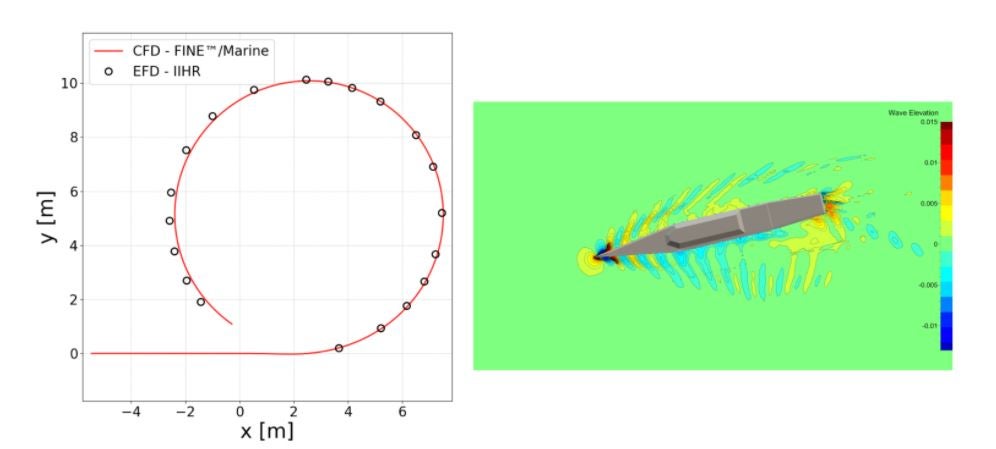Numeca is a developer of specialty computational fluid dynamics (CFD) software solutions, including FINE™/Marine, which naval architects and marine engineers use to reliably simulate hull, appendage, and propeller performance, and discover design improvements at the beginning of the design / refit process.
To ensure the products meet accuracy requirements of the marine industry, Numeca has spent more than a decade participating in global validation workshops, comparing its vessel simulation results with real-world data, and it is consistently one of the top performers, often producing results with 1%-2% accuracy.
High-fidelity results
Consistently providing high-fidelity results is a foundational necessity when applying CFD to reduce fuel consumption for dynamic positioning in various operating conditions or when running Velocity Prediction Programmes (VPP) to find the most suitable sail settings for the highest sailing yacht speed, for example.
The VPP matrix in C-Wizard enables users to calculate the performance of sailing yachts and hydrofoils. Numeca has years of experience in efficiently organising matrices of runs in a user-friendly way. Scripting can easily be implemented to spread the runs and collect the results so users can fully focus on understanding physics.
CFD software for marine applications
FINE™/Marine has a number of features and models designed specifically for marine simulations that further enhance reliability and usability. An example of this is Adaptive Grid Refinement, which automatically refines the free surface mesh during the calculation to capture details as they arise. It also enables different operating conditions to be calculated on a single initial mesh.
To back up the highly tuned algorithms and models, the FINE™/Marine interface is designed with the marine user and naval architect in mind. Due to the guiding C-Wizard, users can set up projects such as resistance calculations, propulsion and seakeeping simulations, and manoeuvring testing with only a handful of clicks. Experienced users can customise boundary conditions to nearly any marine-related fluid flow simulation, including multiple vessels, tow ropes / cables, and second-vessel deployment. With our standard new user training and on-boarding process, customers can go from installation to results quickly, even without prior CFD experience.
FINE™/Marine features a variety of mesh strategies for bodies with motions, including weighted mesh deformations (ship trim and sink), sliding grids (propeller rotation), and overset grids (complex motions, appendages). Overset meshing has clear advantages for parametric studies and is essential for large movements. Adaptive Grid Refinement refines the free surface during calculation and enables different operating conditions to be calculated in one single mesh. The unique compatibility of overset meshing with adaptive grid refinement ensures mesh continuity and the reduction of numerical error within the two overlapping meshes.
Marine software consulting services
In addition to providing CFD software and related Cloud services, Numeca often works hand-in-hand with naval architects, shipyards, and yacht designers in a consulting capacity. Whether customers need a one-off hull analysis or a dedicated CFD partner for deep design optimisation using artificial intelligence, Numeca offers expertise and support.
Reducing engineering time for CFD simulation
The C-Wizard reduces engineering time for CFD simulation set-up through an automated process. The guiding interface option uses all scripting tools available to automatically set up different applications such as resistance at low and high Froude numbers, seakeeping, (self-)propulsion, planing hulls, VPP, and trim optimisation. All types of vessels are eligible for the C-Wizard, including tankers, containers, high-speed crafts, sailing or luxury yachts, and even hydrofoils and open-water propellers.
Resistance calculation
Resistance calculation is a standard in FINE™/Marine and can be set up automatically. Due to Numeca’s convergence booster and various methods such as sub-cycling, quasi-static, and multigrid for the pressure solver, the RANS solver accelerates calculations up to five times for resistance cases while maintaining industry-leading accuracy.
Wave generation
FINE™/Marine can be used to model regular, irregular, or user-defined waves. Waves can be generated from boundaries or by using internal wave generators. Algorithms have been developed to ensure the damping of the waves as they evacuate the domain, rather than being numerically reflected. Additional features such as adaptive grid refinement and overset meshing ensure a robust and tuned solution to evaluate performance in waves.
Users can also explore complex motion simulations at model scale or full scale with dedicated approaches for manoeuvring applications such as Zig-zag, Turning circle, Coursekeeping, and Pure sway.
Propeller modelling
Several options are available for the modelling of propellers and the interaction of the propeller with the hull and appendages. For the design of open propellers, the dedicated C-wizard automatically organises the meshing and solver set-up with appropriate boundary conditions. Numeca’s large validation experience shows the importance of actuator disks for quick and accurate global trends, sliding grid approach for detailed propulsion analysis and turbulence modelling, from standard K-W to advanced DES models, as well as ventilation and cavitation modelling.
Ship design optimisation
FINE™/Marine can be combined with FINE™/Design3D to enable ultra-efficient design optimisation. The parametrisation is easy due to the Grasshopper tool available from within Rhino. Various objectives can be defined for ship optimisation. For example, decreasing ship drag in the calm sea or waves, reducing dynamic trim angle amplitude for passenger comfort, and improving propeller efficiency to reduce the required power. These objectives can be checked for several speeds or loading conditions.









